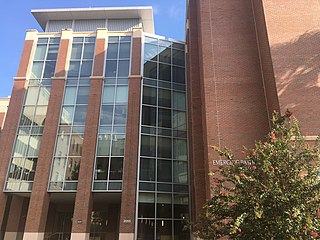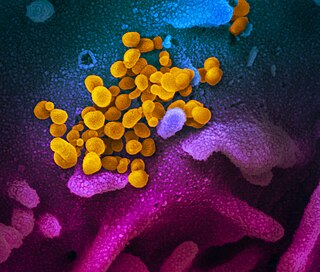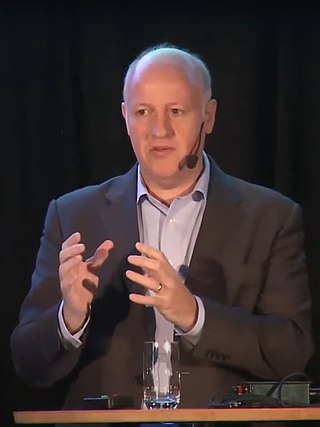Related Research Articles

A zoonosis or zoonotic disease is an infectious disease of humans caused by a pathogen that can jump from a non-human to a human and vice versa.
The University of California, Davis, School of Veterinary Medicine is the largest veterinary school in the United States. Established in 1948, the school is the primary health resource for California's various animal populations. In 2020, the school was again ranked No. 1 in the United States by U.S. News & World Report and in 2022, ranked No. 2 in the world by QS World University Rankings. The school is located in the southwest corner of the main campus of the University of California, Davis. The current Dean of Veterinary Medicine is Dr. Mark Stetter.
EcoHealth Alliance is a US-based non-governmental organization with a stated mission of protecting people, animals, and the environment from emerging infectious diseases. The nonprofit focuses on research aimed at preventing pandemics and promoting conservation in hotspot regions worldwide.
An emergent virus is a virus that is either newly appeared, notably increasing in incidence/geographic range or has the potential to increase in the near future. Emergent viruses are a leading cause of emerging infectious diseases and raise public health challenges globally, given their potential to cause outbreaks of disease which can lead to epidemics and pandemics. As well as causing disease, emergent viruses can also have severe economic implications. Recent examples include the SARS-related coronaviruses, which have caused the 2002-2004 outbreak of SARS (SARS-CoV-1) and the 2019–21 pandemic of COVID-19 (SARS-CoV-2). Other examples include the human immunodeficiency virus which causes HIV/AIDS; the viruses responsible for Ebola; the H5N1 influenza virus responsible for avian flu; and H1N1/09, which caused the 2009 swine flu pandemic. Viral emergence in humans is often a consequence of zoonosis, which involves a cross-species jump of a viral disease into humans from other animals. As zoonotic viruses exist in animal reservoirs, they are much more difficult to eradicate and can therefore establish persistent infections in human populations.

Walter Ian Lipkin is the John Snow Professor of Epidemiology at the Mailman School of Public Health at Columbia University and a professor of Neurology and Pathology at the College of Physicians and Surgeons at Columbia University. He is also director of the Center for Infection and Immunity, an academic laboratory for microbe hunting in acute and chronic diseases. Lipkin is internationally recognized for his work with West Nile virus, SARS and COVID-19.

The Emerging Pathogens Institute (EPI) is an interdisciplinary research institution associated with the University of Florida. The institute focuses on fusing key disciplines to develop outreach, education, and research capabilities designed to preserve the region's health and economy, as well as to prevent or contain new and re-emerging diseases. Researchers within the institute work in more than 30 different countries around the world, with over 250 affiliated faculty members stemming from 11 University of Florida colleges, centers, and institutes. The 90,000-square-foot building includes laboratories and collaborative space for bioinformatics and mathematical modeling.
The One Health Institute works at the interface of animals, people, plants, and the environment to solve complex problems that impact health and conservation around the world. The institute is part of the UC Davis School of Veterinary Medicine and is home to the Karen C. Drayer Wildlife Health Center and many other programs and projects. The executive director of the One Health Institute is Dr. Michael Ziccardi. The One Health approach recognizes that the health of domestic animals, wildlife, and people are inextricably linked to one another and the environment.

Jonna Ann Keener Mazet is an American epidemiologist and Executive Director of the University of California, Davis One Health Institute. Recognized for her innovative and holistic approach to emerging environmental and global health threats, she is an elected member of the National Academy of Medicine and a fellow of the American Association for the Advancement of Science. Mazet is a professor of Epidemiology and Disease Ecology at the UC Davis School of Veterinary Medicine, where she focuses on global health problem solving, especially for emerging infectious disease and conservation challenges.

Disease X is a placeholder name that was adopted by the World Health Organization (WHO) in February 2018 on their shortlist of blueprint priority diseases to represent a hypothetical, unknown pathogen that could cause a future epidemic. The WHO adopted the placeholder name to ensure that their planning was sufficiently flexible to adapt to an unknown pathogen. Director of the US National Institute of Allergy and Infectious Diseases Anthony Fauci stated that the concept of Disease X would encourage WHO projects to focus their research efforts on entire classes of viruses, instead of just individual strains, thus improving WHO capability to respond to unforeseen strains. In 2020, experts, including some of the WHO's own expert advisors, speculated that COVID-19, caused by the SARS-CoV-2 virus strain, met the requirements to be the first Disease X.

Wildlife trafficking practices have resulted in the emergence of zoonotic diseases. Exotic wildlife trafficking is a multi-billion dollar industry that involves the removal and shipment of mammals, reptiles, amphibians, invertebrates, and fish all over the world. Traded wild animals are used for bushmeat consumption, unconventional exotic pets, animal skin clothing accessories, home trophy decorations, privately owned zoos, and for traditional medicine practices. Dating back centuries, people from Africa, Asia, Latin America, the Middle East, and Europe have used animal bones, horns, or organs for their believed healing effects on the human body. Wild tigers, rhinos, elephants, pangolins, and certain reptile species are acquired through legal and illegal trade operations in order to continue these historic cultural healing practices. Within the last decade nearly 975 different wild animal taxa groups have been legally and illegally exported out of Africa and imported into areas like China, Japan, Indonesia, the United States, Russia, Europe, and South America.

Severe acute respiratory syndrome coronavirus 2 (SARS‑CoV‑2) is a strain of coronavirus that causes COVID-19, the respiratory illness responsible for the COVID-19 pandemic. The virus previously had the provisional name 2019 novel coronavirus (2019-nCoV), and has also been called human coronavirus 2019. First identified in the city of Wuhan, Hubei, China, the World Health Organization designated the outbreak a public health emergency of international concern from January 30, 2020, to May 5, 2023. SARS‑CoV‑2 is a positive-sense single-stranded RNA virus that is contagious in humans.

The Coronavirus Preparedness and Response Supplemental Appropriations Act, 2020 is an act of Congress enacted on March 6, 2020. The legislation provided emergency supplemental appropriations of $8.3 billion in fiscal year 2020 to combat the spread of coronavirus disease 2019 (COVID-19) and counter the COVID-19 pandemic, particularly the COVID-19 pandemic in the United States. The legislation passed the House 415–2 on March 4 and the Senate 96–1 on March 5, 2020. The legislation received broad bipartisan support.

Syra Madad is an American pathogen preparedness expert and infectious disease epidemiologist. Madad is the Senior Director of the System-wide Special Pathogens Program at NYC Health + Hospitals where she is part of the executive leadership team which oversees New York City's response to the Coronavirus disease 2019 pandemic in the city's 11 public hospitals. She was featured in the Netflix documentary series Pandemic: How to Prevent an Outbreak and the Discovery Channel documentary The Vaccine: Conquering COVID.
Pandemic prevention is the organization and management of preventive measures against pandemics. Those include measures to reduce causes of new infectious diseases and measures to prevent outbreaks and epidemics from becoming pandemics.
Planning and preparing for pandemics has happened in countries and international organizations. The World Health Organization writes recommendations and guidelines, though there is no sustained mechanism to review countries' preparedness for epidemics and their rapid response abilities. National action depends on national governments. In 2005–2006, before the 2009 swine flu pandemic and during the decade following it, the governments in the United States, France, UK, and others managed strategic health equipment stocks, but they often reduced stocks after the 2009 pandemic in order to reduce costs.

Peter Daszak is a British zoologist, consultant and public expert on disease ecology, in particular on zoonosis. He is the president of EcoHealth Alliance, a nonprofit non-governmental organization that supports various programs on global health and pandemic prevention. He is also a member of the Center for Infection and Immunity at the Columbia University Mailman School of Public Health. He lives in Suffern, New York.

The COVID-19 pandemic has affected animals directly and indirectly. SARS-CoV-2, the virus that causes COVID-19, is zoonotic, which likely to have originated from animals such as bats and pangolins. Human impact on wildlife and animal habitats may be causing such spillover events to become much more likely. The largest incident to date was the culling of 14 to 17 million mink in Denmark after it was discovered that they were infected with a mutant strain of the virus.

The COVID-19 lab leak theory, or lab leak hypothesis, is the idea that SARS-CoV-2, the virus that caused the COVID-19 pandemic, came from a laboratory. This claim is highly controversial; most scientists believe the virus spilled into human populations through natural zoonosis, similar to the SARS-CoV-1 and MERS-CoV outbreaks, and consistent with other pandemics in human history. Available evidence suggests that the SARS-CoV-2 virus was originally harbored by bats, and spread to humans from infected wild animals, functioning as an intermediate host, at the Huanan Seafood Market in Wuhan, Hubei, China, in December 2019. Several candidate animal species have been identified as potential intermediate hosts. There is no evidence SARS-CoV-2 existed in any laboratory prior to the pandemic, or that any suspicious biosecurity incidents happened in any laboratory.
Christine Kreuder Johnson is an American epidemiologist and veterinary scientist who is Professor and Director of the EpiCenter for Disease Dynamics at the One Health Institute. She serves as Professor of Epidemiology and Ecosystem Health at the University of California, Davis. She was elected Fellow of the National Academy of Medicine in 2021.

David Hayman is a New Zealand-based epizootic epidemiologist and disease ecologist whose general multi-disciplinary work focuses on the maintenance of infectious diseases within their hosts and the process of emergence and transmission to humans specifically related to bats. He has gathered data on the relationship between ecological degradation due to anthropogenic actions, and increased pathogen emergence in humans and animals. During COVID-19 he was involved as an expert in several international collaborations, some convened by the World Health Organization, and was a regular commentator in the New Zealand media about the country's response to the pandemic. He has had lead roles in research organisations at Massey University and Te Pūnaha Matatini and was the recipient of the 2017 Rutherford Discovery Fellowship Award. Since 2014 Hayman has been a professor at Massey University.
References
- 1 2 3 Johnson, Jeanne (n.d.). "The Virus Hunters -- Tracking Down the Next HIV". Association of American Veterinary Medicine Colleges. Archived from the original on 2020-03-14. Retrieved 2020-03-16.
- 1 2 McNeil Jr., Donald G. (25 October 2019). "Scientists Were Hunting for the Next Ebola. Now the U.S. Has Cut Off Their Funding". The New York Times. Retrieved 16 March 2020.
- 1 2 3 Morrison, Jim (25 January 2018). "Can Virus Hunters Stop the Next Pandemic Before It Happens?". Smithsonian . Retrieved 16 March 2020.
- ↑ Predict , EcoHealth Alliance (last accessed April 7, 2020).
- 1 2 3 4 5 6 7 Emily Baumgaertner & James Rainey, Trump administration ended coronavirus detection program, Los Angeles Times (April 2, 2020).
- ↑ Cima, Greg (15 January 2020). "Pandemic prevention program ending after 10 years". JAVMA News. American Veterinary Medical Association. Retrieved 16 March 2020.
- 1 2 Schmidt, Charles (2020-04-03). "Why the Coronavirus Slipped Past Disease Detectives". Scientific American. Retrieved 2020-04-06.
- 1 2 3 Zachary Cohen, Trump administration shuttered pandemic monitoring program, then scrambled to extend it, CNN (April 10, 2020).
- ↑ "Letter from Senator Elizabeth Warren and Senator Angus S. King, Jr., to USAID Administrator Mark Green" (PDF). January 30, 2020.